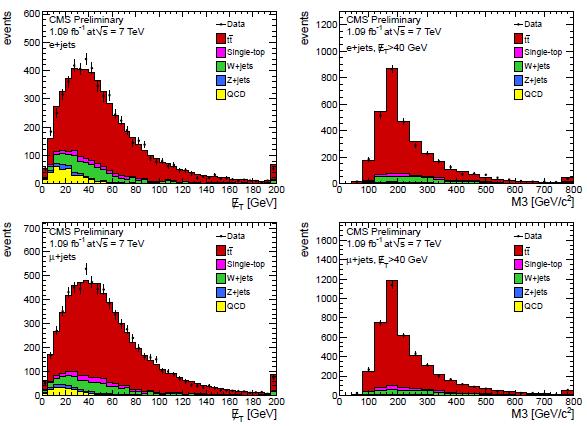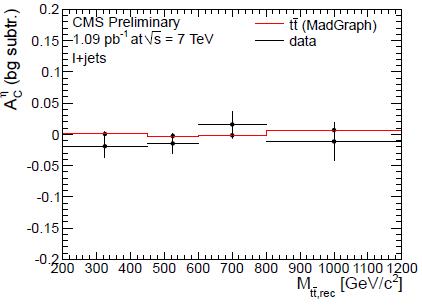One inverse femtobarn is a tenth of what CDF and DZERO are currently analyzing, so what am I talking about ? Well, the top pair cross section in 7-TeV collisions is over twenty times larger than what it is in 2-TeV proton-antiproton collisions, so the CMS bounty of top quarks is already twice larger than that of the Tevatron competitors. Actually more than that, since CMS is of course a newer, and better, detector, with larger acceptance to muons and electrons. What is astonishing is that such huge datasets of top quarks have been collected in little more than three months!
A paper just released by CMS describes a nice analysis, which uses the large set of top quark pairs to try and determine whether the observed rapidity asymmetry in top production observed by both CDF and DZERO is a mere fluctuation, a systematic effect due to standard physics, or a real signal of new physics. The conclusions ? Hmm, not so fast.
What is this about ?
If you have not followed the matter in the course of the last year or so, the summary is as follows: the Tevatron experiments observe an asymmetry in the number of top quarks produced forward (in the direction of the proton beam) or backward (i.e., in the antiproton beam direction). The effect seen by both CDF and DZERO amounts to little more than two standard deviations overall, but in the CDF analysis rises to over three standard deviations if only high-mass (i.e., more energetic) top-antitop pairs are selected -the ones which might more readily be influenced by the production of some unknown new physics.
Are these three sigma something really interesting, or is it an artifact of some kind ? After all, asymmetries belong to the realm of kinematical effects whic h may be influenced by subtle detector features. True, CDF and DZERO are speaking with a single voice here; and this is the reason for the flurry of papers which have appeared in the last year or so on possible causes of the observed effect. An independent verification from a different experiment, however, is very much wanted.
It is important to note that at the LHC due to the symmetry of the initial state (protons from there, protons from here) a charge asymmetry would not appear as a predominance of top quarks emitted in a direction (or antitop ones in the opposite one). However, the fraction of top pairs produced by quark-antiquark annihilation does exhibit a sensitivity on the parton distribution functions of quarks and antiquarks in the proton. One expects a different width of the rapidity distribution of the emitted top and antitop quarks from these processes. This causes a small overall asymmetry, much smaller than that expected (for Standard Model processes) at the Tevatron. Such asymmetry is hardly measurable yet: but new physics would certainly affect the picture, so the verification is worthwhile.
The CMS analysis
The CMS analysis selects top quark pair decays using events triggered by the presence of a high-transverse-momentum electron or muon. The final state selected is one containing a charged lepton (e or mu), large missing transverse energy, and four or more jets, one of which tagged as coming from b-quark fragmentation. Such a selection is the best compromise between signal acceptance and background rejection, and collects 12757 events, 10236+-258 of which are estimated to be top-antitop signal events. Background and signal content are determined with a data-driven technique, but I wish to avoid entering these unnecessary details here. Read the paper if you really need those...
The figure below shows what a bounty of top-antitop pairs (red histogram) has been collected by CMS with this one inverse femtobarn of data: the statistics is indeed impressive. The variables shown are the missing transvers energy in the left panels, and the three-jet invariant mass of the jjj combination with largest vectorial sum of transverse momenta on the right. The top panels refer to electron plus jets events, and the bottom panels show muon plus jets events. Backgrounds are shown in yellow (QCD), green (W plus jets events), and pink (single top production events); the contribution from Z plus jets production is irrelevant. Note that the plots on the right have only events with missing transverse energy above 40 GeV -this explains the much smaller background component.

The best assignment of jets to partons in order to infer the full kinematics of signal events is chosen by an estimator which considers the top and antitop mass hypotheses and the hadronically-decaying W boson; the b-quark-tagged jet is also accounted for. The method chosen by CMS is capable of correctly identifying the jet combination which corresponds to the quarks from top-antitop decay 29% of the time; in events where all final state quarks produce an identified jet, this fraction rises to 51%. This should be considered a pretty good result, due to the large fraction of events where initial or final state gluon radiation "fools" us by producing jets which are more energetic and central than those directly coming from the decay of the heavy bodies.
In order to obtain a well-defined asymmetry variable which can be compared with theory, CMS performs a background subtraction and a regularized unfolding of the measured quantity, the rapidity difference of top and antitop quarks. I think unfolding is in general a dangerous procedure given the lack of a very solid prescription on how to best perform it in experimental problems such as the one at hand, but I know that the CMS analysis passes a very large set of tests and cross checks. In the end, the measured asymmetry is found to be very small and compatible with zero (and with the SM prediction): in pseudorapidity space the value is -0.016 +- 0.030 +0.010 -0.019, if you are curious.
Results
 The figure on the right shows the measured asymmetry as a function of the total invariant mass of the top-antitop system. The result (black points) is very much in agreement with SM calculations (red line).
The figure on the right shows the measured asymmetry as a function of the total invariant mass of the top-antitop system. The result (black points) is very much in agreement with SM calculations (red line).In the end, the CMS analysis is not refuting (but much less confirming) the effect observed at the Tevatron. Quoting the paper:
As opposed to the Tevatron measurements, where the measured asymmetry has been found to be significantly larger than predicted, we measure a small negative asymmetry which is within the uncertainties still very well compatible with the SM predictions and shows no tendency to large deviations from the prediction. [...]. For a quantitative statement of this behavior a proper simultaneous unfolding in both the sensitive variable and the invariant mass of the top-antitop system will be performed in the future in order to confirm or to refute the Tevatron findings.
So, to summarize: the matter is not settled yet. On the other hand, if new physics were kicking in at high energy, one would be expecting for sure that it would affect the LHC measurements than the Tevatron ones. So sceptics like myself are sure to be found telling you that you should forget this as the place where the Standard Model will be found crumbling down.




Comments